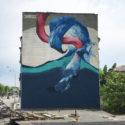 Belgian street artist Smates, known for his hyperrealistic murals, just finished this new wall for the amazing project Art United us in Kiev, Ukraine.
Belgian street artist Smates, known for his hyperrealistic murals, just finished this new wall for the amazing project Art United us in Kiev, Ukraine.
Titled “”A Flamenco in Kiev”, the new mural is characteristic of his work, showing two hyperrealistic and interlaced flamenco heads, one showing a pink flamingo submerging its head under water whilst the other one is created by the water splash of the first one.
Bart Smates is from Mechelen Belgium, a city in the province of Antwerp, in the Flemish part of Belgium. The artist has not expressed himself on the issue yet, but as far as we know “flamenco” is a Spanish word first used to describe the Gypsy dance in Andalusia. The word in Spanish meant “a Fleming, native of Flanders” (Dutch Vlaming) and also “flamingo.” Speculation are varied and colourful about the connection between the bird, the people, and the gypsy dance of Andalusia.
Spain ruled Flanders for many years in XVI century, and King Carlos I brought with him to Madrid an entire Flemish court. One etymology suggests the dance was so called from the bright costumes and energetic movements, which the Spanish associated with Flanders; another is that Spaniards, especially Andalusians, like to name things by their opposites, and because the Flemish were tall and blond and the gypsies short and dark, the gypsies were called “Flemish;” others hold that flamenco was the general Spanish word for all foreigners, gypsies included; or that Flemish noblemen, bored with court life, took to slumming among the gypsies. (Source)
Anyhow, here a few images of the work for Art United us curated by Geo Leros, Iryna Kanishcheva, Waone Interesni Kazki, Ilya Sagaidak .
Images by Geo Leros (except second image by the artist)
More info about:
Smates Website | Facebook
Art United us Website | Facebook | Instagram | Vimeo
Author: Fran
Founder and editor of Urbanite. Street Art lover who after the finishing her MA thesis on the Mexican and Norwegian muralist movement in the 1920-50s, developed a fascination for street art and graffiti that eventually led to collaborations with different art blogs, including the creation of this one.






You must be logged in to post a comment.